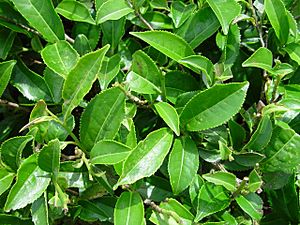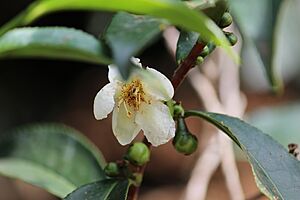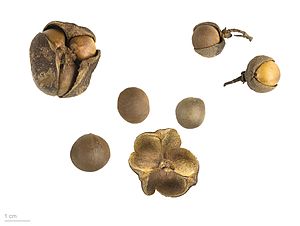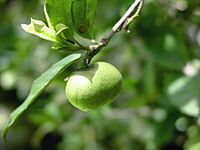Tea plant facts for kids
Quick facts for kids Tea plant |
|
|---|---|
 |
|
 |
|
| Camellia sinensis foliage | |
| Conservation status | |
| Scientific classification | |
| Genus: |
Camellia
|
| Species: |
sinensis
|
 |
|
| Native range of Camellia sinensis | |
| Synonyms | |
|
Camellia sinensis
|
|
Camellia sinensis is a type of evergreen plant. It can be a shrub or a small tree. Its leaves, leaf buds, and stems are used to make tea. People often call it the tea plant or tea shrub. It is not related to the "tea tree" that gives us tea tree oil.
Did you know that all kinds of tea, like white tea, yellow tea, green tea, oolong, dark tea (including pu-erh tea), and black tea, come from Camellia sinensis? There are two main types grown today: C. sinensis var. sinensis and C. s. var. assamica. The difference in teas comes from how they are processed. For example, black tea is very oxidized, while white tea is hardly oxidized at all. Even Kukicha (twig tea) comes from this plant, but it uses twigs and stems instead of just leaves.
Contents
What is the Tea Plant Like?
Camellia sinensis originally comes from East Asia, the Indian Subcontinent, and Southeast Asia. Today, it is grown all over the world in warm, wet places. It is an evergreen plant, meaning its leaves stay green all year. When grown for tea, it is usually kept trimmed to about 2 meters (6.5 feet) tall. It has a strong main root that grows deep into the ground.
The flowers of the tea plant are yellow-white. They are about 2.5 to 4 centimeters (1 to 1.5 inches) wide and have seven or eight petals.
The seeds of C. sinensis can be pressed to make tea oil. This oil is used for cooking and seasoning food. It is important not to confuse it with tea tree oil, which is used for medicine and comes from a different plant.
The leaves are usually 4 to 15 centimeters (1.5 to 6 inches) long and 2 to 5 centimeters (0.8 to 2 inches) wide. Fresh leaves contain about 4% caffeine. They also have other similar compounds. The young, light-green leaves are best for making tea. They have short, white hairs on their underside. Older leaves are a darker green.
Different ages of leaves make different qualities of tea. This is because their chemical makeup changes as they grow. Usually, only the tip (bud) and the first two or three leaves are picked for tea. This picking is done by hand every one to two weeks.
How the Tea Plant Got Its Name
The name Camellia comes from the Latin name of Georg Kamel. He was a Jesuit brother, pharmacist, and missionary. He lived from 1661 to 1706.
Carl Linnaeus chose the name in 1753 to honor Kamel's work with plants. The word sinensis means "from China" in Latin.
There are four main types, or varieties, of C. sinensis. Two of these, C. sinensis var. sinensis and C. s. var. assamica, are most often used for tea. The other two are sometimes used in local areas.
Tea plants are native to East Asia. They likely started in the areas where northern Burma and southwestern China meet.
- Chinese (small leaf) tea [C. sinensis var. sinensis]
- Chinese Western Yunnan Assam (large leaf) tea [C. sinensis var. assamica]
- Indian Assam (large leaf) tea [C. sinensis var. assamica]
- Chinese Southern Yunnan Assam (large leaf) tea [C. sinensis var. assamica]
Chinese small leaf tea may have come from southern China. We don't know exactly where because no wild plants of this type have been found.
Different Types of Tea Plants
There are hundreds, maybe even thousands, of different types of C. sinensis plants. These are called cultivars. Some Japanese types include Benifuuki and Yabukita.
Growing Tea Plants
Camellia sinensis is mostly grown in warm, wet places. These areas need at least 127 centimeters (50 inches) of rain each year. Tea plants like rich, moist soil and lots of sun. They can grow in many different climates.
Many high-quality teas are grown in high places, up to 2,200 meters (7,200 feet) high. This is because the plants grow slower there and get more flavor.
If left alone, tea plants can grow into tall trees. But when they are grown for tea, farmers prune them to waist height. This makes it easier to pick the leaves. The two main types grown are the small-leaved Chinese variety (C. s. sinensis) and the large-leaved Assamese variety (C. s. assamica). The Assamese type is mainly used for black tea.
Chinese Teas
The Chinese tea plant is a small bush with many stems. It can grow up to 3 meters (10 feet) tall. It is native to southeast China. This was the first type of tea plant discovered and used to make tea, about 3,000 years ago. It makes some of the most popular teas.
Indian Teas
Three main kinds of tea are made in India:
- Assam tea comes from the assamica plant. This plant grows in the low, heavily forested northeastern part of India called Assam. Tea from here is rich and full-bodied. The first tea farm in India was started in Assam in 1837.
- Darjeeling tea comes from the sinensis plant. It grows in the cool, wet Darjeeling highlands, near the Himalayas. These tea farms can be as high as 2,200 meters (7,200 feet). Darjeeling tea has a delicate flavor and is thought to be one of the best teas in the world.
- The Darjeeling farms have three main harvests, called 'flushes'. Each flush makes tea with a different flavor. The first (spring) flush teas are light and smell nice. The second (summer) flush makes tea with a bit more strength. The third (autumn) flush gives a tea that is not as high quality.
- Nilgiri tea comes from a southern region of India. It is almost as high as Darjeeling. Nilgiri teas are grown between 1,000 and 2,500 meters (3,300 and 8,200 feet) high. They are gentle and often mixed with other stronger teas.
Pests and Diseases
Some plant-eating animals, like the caterpillars of the willow beauty moth, eat tea leaves.
Health Effects of Tea
People have believed for a long time that tea is good for your health. However, there is no strong scientific proof that tea gives big health benefits. Scientists have studied tea a lot to see if it can lower the risk of human diseases. But as of 2017, this research is not yet definite.
Why Tea Has Caffeine
Caffeine is a natural chemical made by the C. sinensis plant. It acts like a natural pesticide. It can make plant-eating insects unable to move or even kill them. This helps protect the tea plant from being eaten.
Images for kids
See also
 In Spanish: Planta del té para niños
In Spanish: Planta del té para niños
- Chinese herbology
- Green tea extract
- International Code of Nomenclature for Cultivated Plants
- ISO 3103, a method of brewing tea according to the ISO
- Kaempferol, a flavanoid found in tea and associated with reduced risk of heart disease
- List of tea companies
- Tasseography, a method of divination by reading tea leaves.
- Tea classics
- Tea production in Sri Lanka
- Turkish tea
- Tea production in Kenya
- Tea leaf grading
- Camellia taliensis











